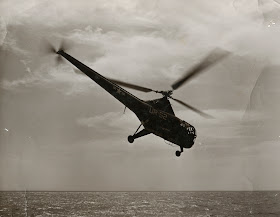The Sikorsky HO3S-1, affectionately known as the “Horse” (the S-51 to Sikorsky, and the R-5/H-5 to the Army and Air Force; the Brits license-built it as the Westland Dragonfly), was the first widely successful helicopter used after WWII.
The Navy first tried the HO3S-1 in 1946, and on December 25, 1946, a Horse from Navy squadron VX-3 became the first helicopter to fly in Antarctica. Pleased with its capabilities, the Navy began ordering the type in larger numbers in 1948.
The tail code UR indicates that this was a member of Helicopter Utility Squadron 2, Detachment 3. The Horse saw extensive use as a rescue helo in Korea until being replaced by the larger and more powerful Sikosky H-19/HO4S Chickasaw. By 1957, all the HO3S aircraft had been retired from the fleet.
The USS Albany started life as CA-123, an Oregon City-class heavy cruiser, being launched on June 30, 1945. From 1958-62, she was overhauled and converted to the Navy’s first guided missile cruiser, taking on a very different look. When new, the Albany and the other ships in her class were equipped with four seaplanes, but these and their launch catapults were replaced by four Sikorskys and a helipad (I have not seen a date for Albany’s switchover, but her sister ship, the USS Rochester, had the catapults replaced with a helipad in late 1948, so presumably this work was done to the Albany at about the same time). I have only been able to locate one other photo of an Albany-based HO3S, which can be seen at this link (but you have to manually go to page 31), showing a Horse landing on the Albany's aft gun turret.

No comments:
Post a Comment